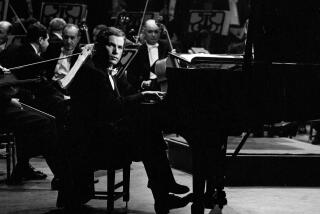Digging Up the Buried Treasures of Paul Hindemith
- Share via
The classical recording industry, which is going off in all directions trying to attract the elusive classical buying public, has lately fixed its sights on the unlikely figure of Paul Hindemith (1895-1963).
During the last decades of his life, spent in the United States as a refugee from Hitler’s Germany, Hindemith epitomized for activist members of the musical community a certain kind of passe academicism. And indeed the rigidly structured, backward-looking--to Max Reger and a few centuries further--scores of Hindemith’s American years clouded the image of a composer once considered aesthetically dangerous enough to be banned by the Third Reich, although he was not a Jew.
Which is not to say that Hindemith’s later music is entirely without interest or value, as witness the lumpily humorous and never quite forgotten “Symphonic Metamorphoses of Themes by Carl Maria von Weber” (1943), a musical sendup of various styles that winds up being, consciously or not, self-mocking as well.
The oddball charm of the piece was never more winning than in Leonard Bernstein’s rough and rowdy 1967 recording with the New York Philharmonic, which has been reissued along with the euphonious if dense “Konzert-musik” for strings and brass of 1930, after which the composer seemed gradually to lose his energy, some later bright spots notwithstanding, until achieving, if that’s the word, the desert-dry Symphony in E-flat of 1940, also heard in this generous program (Sony 47566, mid-price).
The 1920s collection Hindemith titled, simply, “Kammermusik” (chamber music) is, on the other hand, consistently terrific stuff. The case for these seven works, which have been allowed to slip into near-oblivion, is dazzlingly argued on a pair of London CDs (433 816) by members of the Royal Concertgebouw Orchestra conducted by Riccardo Chailly.
The five concertos among the seven pieces are handsomely delivered by a lineup of soloists that includes cellist Lynn Harrell, violist Kim Kashkashian and organist Leon van Doeselaar. Chailly, who seems most engaged by this sort of finely detailed, somewhat cerebral material, is keenly alert to the composer’s bright, often witty notions, be they jazz-inspired, Stravinskyesque, Baroque-derived or romantically lyrical.
Hindemith’s three solo piano sonatas, all published in 1936, were virtually forgotten until Glenn Gould recorded them between 1966 and 1973. They might have been created specifically to display the tastes and talents of the incomparable Canadian pianist (1932-1982), what with their severe contrapuntalism and requirement for the most incisive, clarifying articulation.
The Third Sonata is the crown of the collection, proceeding from innocent charm to monumental grandeur, culminating in a fugue worthy of comparison, in its dignity and complexity, to the six-part Ricercar from Bach’s “Musical Offering.”
Highest marks, too, for Sony’s digital remastering, which reproduces the unique Gould sound with impeccable realism (52670, mid-price).
Gorgeous sonics, but of the glacial variety--apt, in view of what they are applied to--mark a Hindemith program from the San Francisco Symphony under Herbert Blomstedt (London 433 809).
Included are the “Konzert-musik,” stiff and cheerless when compared to the less precise Bernstein-New York version, and a pair of neo-medieval pieces from the late-1930s: the drowsy “Der Schwanendreher,” based on German folk songs (the excellent violist is Geraldine Walther), and “Noblissima Visione,” a high-minded, low-voltage score drawn from a ballet dealing with the life of St. Francis of Assisi.
What the new Hindemith releases--and the above mentioned is only a sampling of the quantity recently issued--fail to acknowledge is that side of the composer’s creative persona that caused widespread gnashing of teeth in the early 1920s: for instance his “Santa Susanna,” a very brief, harrowingly Expressionist opera about sexual obsession, whose only recording (Wergo 60 106-50)--and a hugely successful one it is--features an unforgettable star turn by soprano Helen Donath in the title role.
By all means, seek it out.
More to Read
The biggest entertainment stories
Get our big stories about Hollywood, film, television, music, arts, culture and more right in your inbox as soon as they publish.
You may occasionally receive promotional content from the Los Angeles Times.










